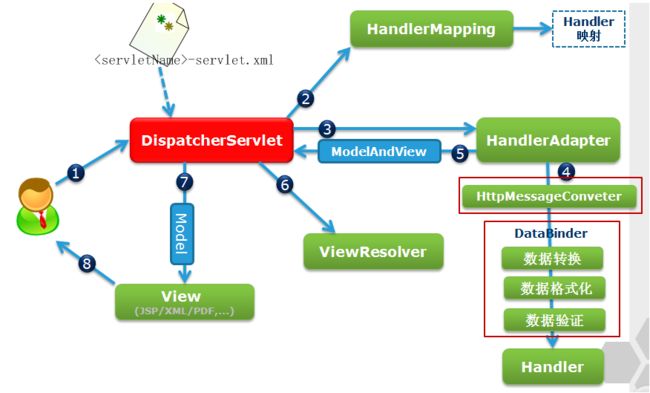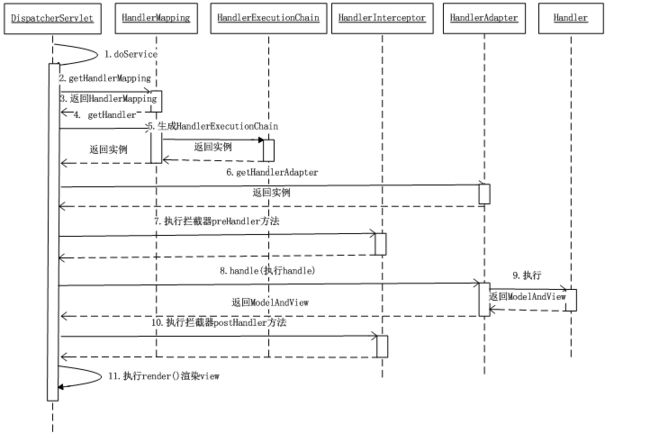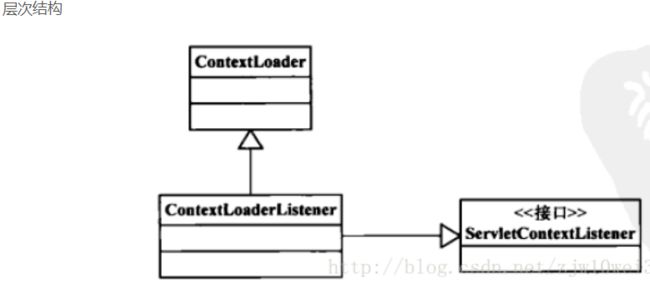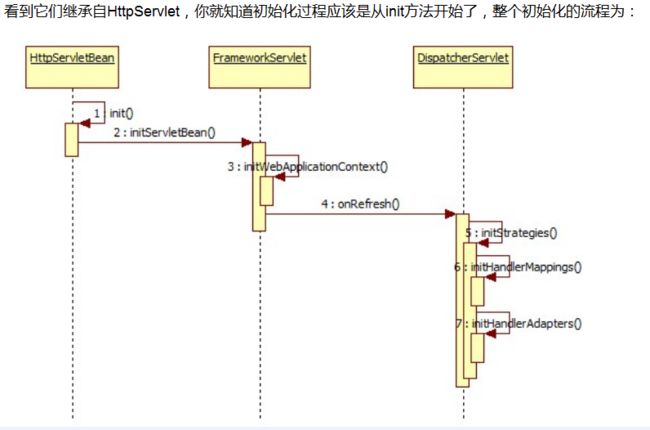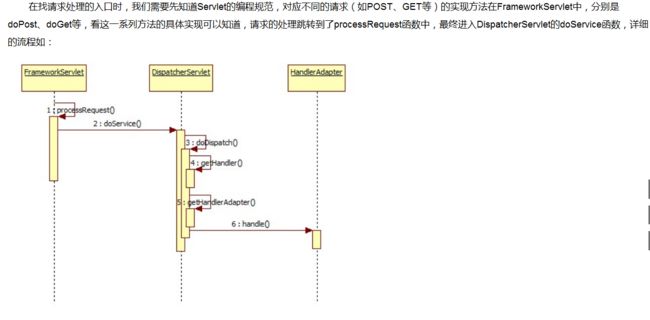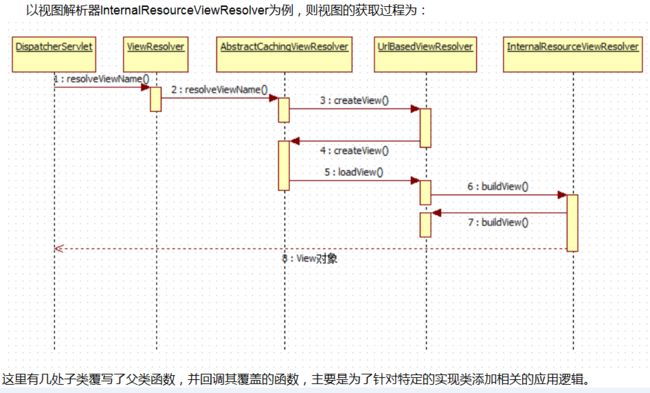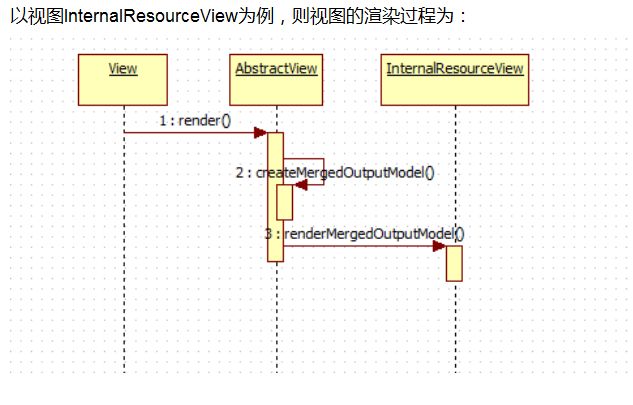1、Spring MVC类图和流程
(1)、Spring MVC流程
例子
时序图
流程描述
- 用户向服务器发送请求,请求被Spring 前端控制DispatcherServlet捕获;
- DispatcherServlet对请求URL进行解析,得到请求资源标识符(URI)。然后根据该URI,调用HandlerMapping获得该Handler配置的所有相关的对象(包括Handler对象以及Handler对象对应的拦截器),最后以HandlerExecutionChain对象的形式返回;
- DispatcherServlet 根据获得的Handler,选择一个合适的HandlerAdapter。(附注:如果成功获得HandlerAdapter后,此时将开始执行拦截器的preHandler(...)方法)
- 提取Request中的模型数据,填充Handler入参,开始执行Handler(Controller)。 在填充Handler的入参过程中,根据你的配置,Spring将帮你做一些额外的工作:
HttpMessageConveter: 将请求消息(如Json、xml等数据)转换成一个对象,将对象转换为指定的响应信息
数据转换:对请求消息进行数据转换。如String转换成Integer、Double等
数据根式化:对请求消息进行数据格式化。 如将字符串转换成格式化数字或格式化日期等
数据验证: 验证数据的有效性(长度、格式等),验证结果存储到BindingResult或Error中 - Handler执行完成后,向DispatcherServlet 返回一个ModelAndView对象;
- 根据返回的ModelAndView,选择一个适合的ViewResolver(必须是已经注册到Spring容器中的ViewResolver)返回给DispatcherServlet ;
- ViewResolver 结合Model和View,来渲染视图
- 将渲染结果返回给客户端。
(2)、类图
(3)、ContextLoaderListener初始化的上下文webapplicationcontext和DispatcherServlet之间的关系
2、源码解析
(1)、ContextLoaderListener初始化过程
ContextLoaderListener实现了ServletContextListener这个接口,在web.xml配置这个监听器,启动容器时,就会默认执行它实现的contextInitialized方法。
public WebApplicationContext initWebApplicationContext(ServletContext servletContext) {
if (servletContext.getAttribute(WebApplicationContext.ROOT_WEB_APPLICATION_CONTEXT_ATTRIBUTE) != null) {
throw new IllegalStateException(
"Cannot initialize context because there is already a root application context present - " +
"check whether you have multiple ContextLoader* definitions in your web.xml!");
}
Log logger = LogFactory.getLog(ContextLoader.class);
servletContext.log("Initializing Spring root WebApplicationContext");
if (logger.isInfoEnabled()) {
logger.info("Root WebApplicationContext: initialization started");
}
long startTime = System.currentTimeMillis();
try {
// Store context in local instance variable, to guarantee that
// it is available on ServletContext shutdown.
if (this.context == null) {
//此时spring容器为null,此处获取Spring IOC容器对象
this.context = createWebApplicationContext(servletContext);
}
if (this.context instanceof ConfigurableWebApplicationContext) {
ConfigurableWebApplicationContext cwac = (ConfigurableWebApplicationContext) this.context;
if (!cwac.isActive()) {
// The context has not yet been refreshed -> provide services such as
// setting the parent context, setting the application context id, etc
if (cwac.getParent() == null) {
// The context instance was injected without an explicit parent ->
// determine parent for root web application context, if any.
ApplicationContext parent = loadParentContext(servletContext);
//此处设置的为null
cwac.setParent(parent);
}
//此处进行初始化容器操作
configureAndRefreshWebApplicationContext(cwac, servletContext);
}
}
//设置servletContext的org.springframework.web.context.WebApplicationContext.ROOT属性
servletContext.setAttribute(WebApplicationContext.ROOT_WEB_APPLICATION_CONTEXT_ATTRIBUTE, this.context);
ClassLoader ccl = Thread.currentThread().getContextClassLoader();
if (ccl == ContextLoader.class.getClassLoader()) {
currentContext = this.context;
}
else if (ccl != null) {
currentContextPerThread.put(ccl, this.context);
}
if (logger.isDebugEnabled()) {
logger.debug("Published root WebApplicationContext as ServletContext attribute with name [" +
WebApplicationContext.ROOT_WEB_APPLICATION_CONTEXT_ATTRIBUTE + "]");
}
if (logger.isInfoEnabled()) {
long elapsedTime = System.currentTimeMillis() - startTime;
logger.info("Root WebApplicationContext: initialization completed in " + elapsedTime + " ms");
}
return this.context;
}
catch (RuntimeException ex) {
logger.error("Context initialization failed", ex);
servletContext.setAttribute(WebApplicationContext.ROOT_WEB_APPLICATION_CONTEXT_ATTRIBUTE, ex);
throw ex;
}
catch (Error err) {
logger.error("Context initialization failed", err);
servletContext.setAttribute(WebApplicationContext.ROOT_WEB_APPLICATION_CONTEXT_ATTRIBUTE, err);
throw err;
}
}
configureAndRefreshWebApplicationContext方法,调用AbstractApplicationContext的refresh方法初始化容器操作
protected void configureAndRefreshWebApplicationContext(ConfigurableWebApplicationContext wac, ServletContext sc) {
if (ObjectUtils.identityToString(wac).equals(wac.getId())) {
// The application context id is still set to its original default value
// -> assign a more useful id based on available information
String idParam = sc.getInitParameter(CONTEXT_ID_PARAM);
if (idParam != null) {
wac.setId(idParam);
}
else {
// Generate default id...
if (sc.getMajorVersion() == 2 && sc.getMinorVersion() < 5) {
// Servlet <= 2.4: resort to name specified in web.xml, if any.
wac.setId(ConfigurableWebApplicationContext.APPLICATION_CONTEXT_ID_PREFIX +
ObjectUtils.getDisplayString(sc.getServletContextName()));
}
else {
wac.setId(ConfigurableWebApplicationContext.APPLICATION_CONTEXT_ID_PREFIX +
ObjectUtils.getDisplayString(sc.getContextPath()));
}
}
}
wac.setServletContext(sc);
//获取contextConfigLocation下spring容器的配置文件
String initParameter = sc.getInitParameter(CONFIG_LOCATION_PARAM);
if (initParameter != null) {
wac.setConfigLocation(initParameter);
}
customizeContext(sc, wac);
//此处调用AbstractApplicationContext的refresh方法,初始化容器
wac.refresh();
}
(2)、DispatcherServlet初始化过程
首先,对于一个web应用,其部署在web容器中,web容器提供其一个全局的上下文环境,这个上下文就是ServletContext,其为后面的spring IoC容器提供宿主环境;
其次,在web.xml中会提供有contextLoaderListener。在web容器启动时,会触发容器初始化事件,此时contextLoaderListener会监听到这个事件,其contextInitialized方法会被调用,在这个方法中,spring会初始化一个启动上下文,这个上下文被称为根上下文,即WebApplicationContext,这是一个接口类,确切的说,其实际的实现类是XmlWebApplicationContext。这个就是spring的IoC容器,其对应的Bean定义的配置由web.xml中的context-param标签指定。在这个IoC容器初始化完毕后,spring以WebApplicationContext.ROOTWEBAPPLICATIONCONTEXTATTRIBUTE为属性Key,将其存储到ServletContext中,便于获取;
再次,contextLoaderListener监听器初始化完毕后,开始初始化web.xml中配置的Servlet,这个servlet可以配置多个,以最常见的DispatcherServlet为例,这个servlet实际上是一个标准的前端控制器,用以转发、匹配、处理每个servlet请求。DispatcherServlet上下文在初始化的时候会建立自己的IoC上下文,用以持有spring mvc相关的bean。在建立DispatcherServlet自己的IoC上下文时,会利用WebApplicationContext.ROOTWEBAPPLICATIONCONTEXTATTRIBUTE先从ServletContext中获取之前的根上下文(即WebApplicationContext)作为自己上下文的parent上下文。
最后,有了这个parent上下文之后,再初始化自己持有的上下文。这个DispatcherServlet初始化自己上下文的工作在其initStrategies方法中可以看到,大概的工作就是初始化处理器映射、视图解析等。这个servlet自己持有的上下文默认实现类也是XmlWebApplicationContext。初始化完毕后,spring以与servlet的名字相关(此处不是简单的以servlet名为Key,而是通过一些转换,具体可自行查看源码)的属性为属性Key,也将其存到ServletContext中,以便后续使用。这样每个servlet就持有自己的上下文,即拥有自己独立的bean空间,同时各个servlet共享相同的bean,即根上下文(第2步中初始化的IOC上下文)定义的那些bean。
FrameworkServlet的initWebApplicationContext
protected WebApplicationContext initWebApplicationContext() {
//获取rootContext ,即spring的IoC容器对象
//(这个对象在ContextLoaderListener初始化IOC容器时就已经把它set到ServletContext的属性中)
WebApplicationContext rootContext =
WebApplicationContextUtils.getWebApplicationContext(getServletContext());
//Sping MVC容器WebApplicationContext
WebApplicationContext wac = null;
//不走该流程
if (this.webApplicationContext != null) {
// A context instance was injected at construction time -> use it
wac = this.webApplicationContext;
if (wac instanceof ConfigurableWebApplicationContext) {
ConfigurableWebApplicationContext cwac = (ConfigurableWebApplicationContext) wac;
if (!cwac.isActive()) {
// The context has not yet been refreshed -> provide services such as
// setting the parent context, setting the application context id, etc
if (cwac.getParent() == null) {
// The context instance was injected without an explicit parent -> set
// the root application context (if any; may be null) as the parent
cwac.setParent(rootContext);
}
configureAndRefreshWebApplicationContext(cwac);
}
}
}
if (wac == null) {
// No context instance was injected at construction time -> see if one
// has been registered in the servlet context. If one exists, it is assumed
// that the parent context (if any) has already been set and that the
// user has performed any initialization such as setting the context id
wac = findWebApplicationContext();
}
if (wac == null) {
// No context instance is defined for this servlet -> create a local one
//创建和初始化spring mvc容器,代码(2-1)
wac = createWebApplicationContext(rootContext);
}
if (!this.refreshEventReceived) {
// Either the context is not a ConfigurableApplicationContext with refresh
// support or the context injected at construction time had already been
// refreshed -> trigger initial onRefresh manually here.
//调用DispatcherServlet的initStrategies方法,代码(2-2)
onRefresh(wac);
}
if (this.publishContext) {
// Publish the context as a servlet context attribute.
String attrName = getServletContextAttributeName();
getServletContext().setAttribute(attrName, wac);
if (this.logger.isDebugEnabled()) {
this.logger.debug("Published WebApplicationContext of servlet '" + getServletName() +
"' as ServletContext attribute with name [" + attrName + "]");
}
}
return wac;
}
(2-1)、创建WebApplicationContext
createWebApplicationContext创建和初始化mvc容器,调用FrameworkServlet的configureAndRefreshWebApplicationContext
//createWebApplicationContext
protected WebApplicationContext createWebApplicationContext(WebApplicationContext parent) {
return createWebApplicationContext((ApplicationContext) parent);
}
//createWebApplicationContext
protected WebApplicationContext createWebApplicationContext(ApplicationContext parent) {
Class contextClass = getContextClass();
if (this.logger.isDebugEnabled()) {
this.logger.debug("Servlet with name '" + getServletName() +
"' will try to create custom WebApplicationContext context of class '" +
contextClass.getName() + "'" + ", using parent context [" + parent + "]");
}
if (!ConfigurableWebApplicationContext.class.isAssignableFrom(contextClass)) {
throw new ApplicationContextException(
"Fatal initialization error in servlet with name '" + getServletName() +
"': custom WebApplicationContext class [" + contextClass.getName() +
"] is not of type ConfigurableWebApplicationContext");
}
//创建mvc容器对象
ConfigurableWebApplicationContext wac =
(ConfigurableWebApplicationContext) BeanUtils.instantiateClass(contextClass);
wac.setEnvironment(getEnvironment());
wac.setParent(parent);
wac.setConfigLocation(getContextConfigLocation());
configureAndRefreshWebApplicationContext(wac);
return wac;
}
FrameworkServlet的configureAndRefreshWebApplicationContext
protected void configureAndRefreshWebApplicationContext(ConfigurableWebApplicationContext wac) {
if (ObjectUtils.identityToString(wac).equals(wac.getId())) {
// The application context id is still set to its original default value
// -> assign a more useful id based on available information
if (this.contextId != null) {
wac.setId(this.contextId);
}
else {
// Generate default id...
ServletContext sc = getServletContext();
if (sc.getMajorVersion() == 2 && sc.getMinorVersion() < 5) {
// Servlet <= 2.4: resort to name specified in web.xml, if any.
String servletContextName = sc.getServletContextName();
if (servletContextName != null) {
wac.setId(ConfigurableWebApplicationContext.APPLICATION_CONTEXT_ID_PREFIX + servletContextName +
"." + getServletName());
}
else {
wac.setId(ConfigurableWebApplicationContext.APPLICATION_CONTEXT_ID_PREFIX + getServletName());
}
}
else {
// Servlet 2.5's getContextPath available!
wac.setId(ConfigurableWebApplicationContext.APPLICATION_CONTEXT_ID_PREFIX +
ObjectUtils.getDisplayString(sc.getContextPath()) + "/" + getServletName());
}
}
}
wac.setServletContext(getServletContext());
wac.setServletConfig(getServletConfig());
wac.setNamespace(getNamespace());
wac.addApplicationListener(new SourceFilteringListener(wac, new ContextRefreshListener()));
// the wac environment's #initPropertySources will be called in any case when
// the context is refreshed; do it eagerly here to ensure servlet property sources
// are in place for use in any post-processing or initialization that occurs
// below prior to #refresh
ConfigurableEnvironment env = wac.getEnvironment();
if (env instanceof ConfigurableWebEnvironment) {
((ConfigurableWebEnvironment)env).initPropertySources(getServletContext(), getServletConfig());
}
postProcessWebApplicationContext(wac);
applyInitializers(wac);
//此处调用AbstractApplicationContext的refresh方法,初始化容器
wac.refresh();
}
(2-2)、调用DispatcherServlet的initStrategies方法
初始化HandlerMapping、HandlerAdapter、ViewResolver
protected void initStrategies(ApplicationContext context) {
initMultipartResolver(context);
initLocaleResolver(context);
initThemeResolver(context);
initHandlerMappings(context);
initHandlerAdapters(context);
initHandlerExceptionResolvers(context);
initRequestToViewNameTranslator(context);
initViewResolvers(context);
initFlashMapManager(context);
}
DispatcherServlet的initHandlerMappings方法
private void initHandlerMappings(ApplicationContext context) {
this.handlerMappings = null;
if (this.detectAllHandlerMappings) {
// Find all HandlerMappings in the ApplicationContext, including ancestor contexts.
Map matchingBeans =
BeanFactoryUtils.beansOfTypeIncludingAncestors(context, HandlerMapping.class, true, false);
if (!matchingBeans.isEmpty()) {
this.handlerMappings = new ArrayList(matchingBeans.values());
// We keep HandlerMappings in sorted order.
OrderComparator.sort(this.handlerMappings);
}
}
else {
try {
HandlerMapping hm = context.getBean(HANDLER_MAPPING_BEAN_NAME, HandlerMapping.class);
this.handlerMappings = Collections.singletonList(hm);
}
catch (NoSuchBeanDefinitionException ex) {
// Ignore, we'll add a default HandlerMapping later.
}
}
// Ensure we have at least one HandlerMapping, by registering
// a default HandlerMapping if no other mappings are found.
if (this.handlerMappings == null) {
this.handlerMappings = getDefaultStrategies(context, HandlerMapping.class);
if (logger.isDebugEnabled()) {
logger.debug("No HandlerMappings found in servlet '" + getServletName() + "': using default");
}
}
}
/DispatcherServlet的initHandlerAdapters方法
private void initHandlerAdapters(ApplicationContext context) {
this.handlerAdapters = null;
if (this.detectAllHandlerAdapters) {
// Find all HandlerAdapters in the ApplicationContext, including ancestor contexts.
Map matchingBeans =
BeanFactoryUtils.beansOfTypeIncludingAncestors(context, HandlerAdapter.class, true, false);
if (!matchingBeans.isEmpty()) {
this.handlerAdapters = new ArrayList(matchingBeans.values());
// We keep HandlerAdapters in sorted order.
OrderComparator.sort(this.handlerAdapters);
}
}
else {
try {
HandlerAdapter ha = context.getBean(HANDLER_ADAPTER_BEAN_NAME, HandlerAdapter.class);
this.handlerAdapters = Collections.singletonList(ha);
}
catch (NoSuchBeanDefinitionException ex) {
// Ignore, we'll add a default HandlerAdapter later.
}
}
// Ensure we have at least some HandlerAdapters, by registering
// default HandlerAdapters if no other adapters are found.
if (this.handlerAdapters == null) {
this.handlerAdapters = getDefaultStrategies(context, HandlerAdapter.class);
if (logger.isDebugEnabled()) {
logger.debug("No HandlerAdapters found in servlet '" + getServletName() + "': using default");
}
}
}
DispatcherServlet的initViewResolvers方法
private void initViewResolvers(ApplicationContext context) {
this.viewResolvers = null;
if (this.detectAllViewResolvers) {
// Find all ViewResolvers in the ApplicationContext, including ancestor contexts.
Map matchingBeans =
BeanFactoryUtils.beansOfTypeIncludingAncestors(context, ViewResolver.class, true, false);
if (!matchingBeans.isEmpty()) {
this.viewResolvers = new ArrayList(matchingBeans.values());
// We keep ViewResolvers in sorted order.
OrderComparator.sort(this.viewResolvers);
}
}
else {
try {
ViewResolver vr = context.getBean(VIEW_RESOLVER_BEAN_NAME, ViewResolver.class);
this.viewResolvers = Collections.singletonList(vr);
}
catch (NoSuchBeanDefinitionException ex) {
// Ignore, we'll add a default ViewResolver later.
}
}
// Ensure we have at least one ViewResolver, by registering
// a default ViewResolver if no other resolvers are found.
if (this.viewResolvers == null) {
this.viewResolvers = getDefaultStrategies(context, ViewResolver.class);
if (logger.isDebugEnabled()) {
logger.debug("No ViewResolvers found in servlet '" + getServletName() + "': using default");
}
}
}
3、Spring MVC请求源码解析
doDispatch函数,spring mvc主要处理流程
protected void doDispatch(HttpServletRequest request, HttpServletResponse response) throws Exception {
HttpServletRequest processedRequest = request;
HandlerExecutionChain mappedHandler = null;
boolean multipartRequestParsed = false;
WebAsyncManager asyncManager = AsyncWebUtils.getAsyncManager(request);
try {
ModelAndView mv = null;
Exception dispatchException = null;
try {
processedRequest = checkMultipart(request);
multipartRequestParsed = processedRequest != request;
// Determine handler for the current request.
mappedHandler = getHandler(processedRequest, false);
if (mappedHandler == null || mappedHandler.getHandler() == null) {
noHandlerFound(processedRequest, response);
return;
}
// Determine handler adapter for the current request.
HandlerAdapter ha = getHandlerAdapter(mappedHandler.getHandler());
// Process last-modified header, if supported by the handler.
……
try {
// Actually invoke the handler.
mv = ha.handle(processedRequest, response, mappedHandler.getHandler());
}
finally {
if (asyncManager.isConcurrentHandlingStarted()) {
return;
}
}
applyDefaultViewName(request, mv);
mappedHandler.applyPostHandle(processedRequest, response, mv);
}
catch (Exception ex) {
dispatchException = ex;
}
processDispatchResult(processedRequest, response, mappedHandler, mv, dispatchException);
}
……
}
finally {
……
}
}
HandlerExecutionChain这个类,有两个关键的东西handler与interceptors,也即处理器对象与拦截器链表
public class HandlerExecutionChain {
private final Object handler;
private HandlerInterceptor[] interceptors;
private List interceptorList;
……
}
doDispatch函数中获得HandlerExecutionChain对象mappedHandler。
函数的实现非常简单:遍历已注册的HandlerMapping列表,通过HandlerMapping对象的getHandler函数获取HandlerExecutionChain对象。至于HandlerMapping中的getHandler函数如何获取HandlerExecutionChain需要的处理器与拦截器,我只能说过程是繁琐的,原理是简单的,对于处理器对象(handler)根据不同的Mapping实现,其可以根据bean配置中的urlPath或者是方法的注解来寻找,这里不再细说。
protected HandlerExecutionChain getHandler(HttpServletRequest request) throws Exception {
for (HandlerMapping hm : this.handlerMappings) {
……
HandlerExecutionChain handler = hm.getHandler(request);
if (handler != null) {
return handler;
}
}
return null;
}
mv = ha.handle(processedRequest, response, mappedHandler.getHandler());
//通过getHandlerAdapter函数获得HandlerAdapter对象ha,随着调用HandlerAdapter的handle函数,Spring MVC便开始要真的“干实事”了,所谓的“干实事”也即开始调用执行我们编写的controller(控制逻辑)了。这里以两个HandlerAdapter的实现HttpRequestHandlerAdapter与AnnotationMethodHandlerAdapter来分析这个处理流程。
HttpRequestHandlerAdapter的实现是最容易理解的,因为其handle的实现就是调用了处理器(handler)对象的handleRequest函数,借助F4看看Controller的继承体系,再看看AbstractController中handleRequest函数的实现。
至于AnnotationMethodHandlerAdapter,其实现原理也是很容易理解的,我们已经知道其就是针对采用注解方式的方法映射的,所以其handle的实现就是通过Java的反射机制找到注解对应的处理方法,并调用完成控制逻辑的执行。
processDispatchResult(processedRequest, response, mappedHandler, mv, dispatchException);
//视图处理。在经过handle的“干实事”后,我们得到了ModelAndView对象,也即视图对象,很自然接下来的就是视图的渲染与展示了。
视图处理时序图
protected void render(ModelAndView mv, HttpServletRequest request, HttpServletResponse response) throws Exception {
// Determine locale for request and apply it to the response.
Locale locale = this.localeResolver.resolveLocale(request);
response.setLocale(locale);
View view;
if (mv.isReference()) {
// We need to resolve the view name.
view = resolveViewName(mv.getViewName(), mv.getModelInternal(), locale, request);
if (view == null) {
throw new ServletException("Could not resolve view with name '" + mv.getViewName() +
"' in servlet with name '" + getServletName() + "'");
}
}
else {
// No need to lookup: the ModelAndView object contains the actual View object.
view = mv.getView();
if (view == null) {
throw new ServletException("ModelAndView [" + mv + "] neither contains a view name nor a " +
"View object in servlet with name '" + getServletName() + "'");
}
}
// Delegate to the View object for rendering.
if (logger.isDebugEnabled()) {
logger.debug("Rendering view [" + view + "] in DispatcherServlet with name '" + getServletName() + "'");
}
try {
view.render(mv.getModelInternal(), request, response);
}
catch (Exception ex) {
if (logger.isDebugEnabled()) {
logger.debug("Error rendering view [" + view + "] in DispatcherServlet with name '" +
getServletName() + "'", ex);
}
throw ex;
}
}
processDispatchResult主要处理异常、请求状态及触发请求完成事件,视图的渲染工作交给了render(),render()判断前面获得的ModelAndView对象是否为引用对象(也即此时有的只是视图的名称,没有获取其实例对象),如果是则需要调用resolveViewName从视图解析器获取对应的视图(View)对象,否则直接以其getView函数获取视图对象。最后,通过具体视图对象的render()函数完成视图的渲染。
Spring MVC中,在控制器处理结束并返回ModelAndView名称后,Spring会依次调用Spring容器中所注册的视图解析器(ViewResolver),来查找符合条件的视图。对于给定的视图名称,只需调用ViewResolver的resolveViewName接口即可获取其视图对象。Spring中默认提供了许多的视图解析器,当然,还有对应类型的视图对象。
如针对JSP提供的InternalResourceViewResolver与InternalResourceView,时序图。
refer:
http://blog.csdn.net/zjw10wei321/article/details/40145241
